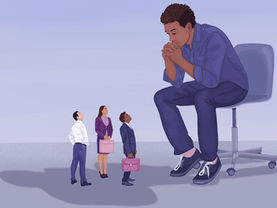Promoting Mental Health Awareness and Its Significance in Modern Society
- Althea Daño

- Jul 15
- 4 min read
What if the thing hurting your mental health the most... lives under your roof?
Many teens struggle with anxiety, emotional instability, and shutdowns—not because they’re “too sensitive” or dramatic, but because they live in environments that constantly violate their peace. We don't talk enough about how damaging it is to grow up in a space that never feels emotionally safe.
For some, home isn’t a haven. It’s where the noise never stops.
“Why are you so sensitive?” “You should be thankful you even have a roof over your head.” “Stop overthinking.”
According to the American Psychological Association, long-term exposure to emotional stress at home can increase the risk of depression, self-doubt, and PTSD in adolescents. But because these environments are normalized, many teens begin to think “maybe it’s just me.”
It’s Not “Just You”
I used to think that too. I’d wake up with this deep discomfort in my body—like I was allergic to the voices, the routines, and even the walls around me. Every knock, every question felt like an interrogation. No matter how quiet I tried to be, it was never quiet enough.
This kind of environment is called emotionally unsafe—and it’s real.
Survival Mode Isn’t Sustainable
When your body is constantly on edge, you’re not “lazy” or “overreacting”—you’re in survival mode. Your nervous system is always alert, ready to protect you from the next emotional blow. But the truth is, we’re not built to live like that long-term.
The World Health Organization emphasizes that mental health is not just the absence of illness—it’s the presence of safety, peace, and emotional support. If your home lacks those, it makes sense that you feel unwell.
It Wasn’t Just Stress—It Was the Environment
I used to think I was just bad at handling stress. That I was too emotional, too soft, too reactive. But over time, I realized it wasn’t school or grades that were breaking me down—it was the environment I came home to every day.
Imagine trying to rest while feeling like your presence is a problem. Every sound I made, every expression I had, felt like it needed approval. I’d try so hard to stay quiet, to not “bother” anyone, but it never seemed enough. I wasn’t allowed to feel tired, sad, or overwhelmed—because “what do you even have to complain about?”
Eventually, I started waking up already exhausted. Not physically, but emotionally. I wasn’t lazy—I was burnt out from surviving in a space that made me feel like I had to earn the right to exist peacefully.
What helped me wasn’t just deep breathing or journaling. It was acknowledging that my feelings were valid. That just because someone else provided a roof didn’t mean they provided emotional safety. And that realization? It gave me the power to slowly reclaim my peace—even if I had to build it from the inside out.
Why This Hurts More Than You Think
The American Psychological Association highlights that adolescence is a critical time for emotional development. Repeated exposure to invalidation, gaslighting, or emotional coldness can make you second-guess your feelings or even start believing you’re “too sensitive.”
In reality, your body is reacting the way it’s supposed to under chronic emotional stress. Symptoms can include:
● Trouble sleeping
● Feeling numb or on edge
● Irritability or frequent crying
● Loss of focus or motivation
● Digestive issues or body aches
If any of these feel familiar, know that your reactions are valid. You’re not “weak” or “dramatic.” You’re responding to a situation that deeply affects your nervous system and emotional well-being.
You're Not Alone—And You're Not Powerless
One in five teens experiences mental health challenges, according to the National Institute of Mental Health. But what’s rarely talked about is how many of these struggles begin at home.
Even if you can't move out or set strong physical boundaries yet, there are still ways to reclaim a sense of emotional space:
● Create micro-moments of peace: Whether it’s music, journaling, or stepping outside, build routines that feel grounding.
● Connect with safe people: A friend, teacher, counselor, or online support group can remind you that someone sees and believes you.
● Name what’s happening: Sometimes just saying, “That was emotional abuse,” helps shift the blame away from yourself.
● Learn to self-validate: You don’t need others to agree with your pain before you treat it as real and worthy of care.
What Healing Looks Like
Healing from an unsafe home doesn’t always start with fixing the environment. It often begins with reminding yourself that your feelings are real. That you deserve to be treated with respect. That even if you're still stuck somewhere painful, your story is not over.
If you need help now, confidential hotlines like Teen Line or Crisis Text Line are here 24/7. You are not invisible. And you are not alone.
Sources:
● CDC: Mental Health
● APA: Mental Health Topics
● NIMH: For Teens
● Harvard Health: Coping with Stress
● Psychology Today: Emotional Neglect
A peaceful forest scene symbolizing calmness and tranquility.
It’s not always easy to talk about mental health—especially when the people around you don’t understand. But that doesn’t mean you have to stay silent.
How do you feel your home environment has affected your mental health? Have you ever felt like you had to “shrink” yourself just to survive?
Feel free to share your story or thoughts in the comments. This space is for you—a place without judgment, only understanding.
A still lake reflecting trees, symbolizing tranquility and calmness.
Key Takeaways
● Many teens struggle not because they’re “weak,” but because they live in emotionally unsafe homes.
● Constant stress at home can lead to long-term mental health challenges.
● Survival mode is not a personality flaw—it’s a nervous system doing its job in a stressful environment.
● Creating safe spaces, both internally and externally, is essential to healing. ● Speaking up, even quietly, is a powerful act of reclaiming peace.
Reflecting on the Journey Ahead
Writing about mental health isn’t just about sharing facts, it's about making space for truth, connection, and healing. When we tell our stories, challenge harmful beliefs, and create safe environments for others, we help change the conversation.
No matter where you are in your journey, remember: healing isn’t linear, but it is possible. One step, one breath, one brave moment at a time.
A tranquil sunset over the ocean, symbolizing hope and serenity.















Comments